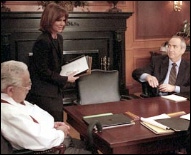|
Home Court Advantage
by Paul Joseph
There are a number of similarities
between the new ABC Supreme Court show, The Court, and
its competition, First Monday.
Both focus on a new Justice appointed to an evenly divided (liberal/conservative)
Supreme Court. Both purport to take us "behind the scenes"
to watch the Court's inner workings. Both focus on the interpersonal
relations between the Justices and between the Justices and their
clerks. Both move us out of the courtroom to address the human
side of the cases. Both use the device of news and commentary
television as a sort of Greek chorus, commenting on the action.
 Despite
these structural similarities, the programs are dramatically
different. While First Monday quickly sunk into self-parody,
clownish characterizations and downright embarrassing portrayals
of court personnel and procedure, The Court, with its
intelligent writing and careful plot-crafting, delivers a classy
adult drama. Despite
these structural similarities, the programs are dramatically
different. While First Monday quickly sunk into self-parody,
clownish characterizations and downright embarrassing portrayals
of court personnel and procedure, The Court, with its
intelligent writing and careful plot-crafting, delivers a classy
adult drama.
Sally Field, as newly appointed
Justice without ideology Kate Nolan, heads an experienced cast
of players who, even in the first show, deliver convincing and
interesting portrayals. When, at the end of the program, reporter
Harlan Brandt (Craig Bierko) tells us that Nolan, like the inmate
in a case before the Court, has also been given a kind of "life
sentence," our response is that we want to come back and
watch as it unfolds. We have the sense that not only Kate Nolan
but all the principal characters have lives with depths not yet
obvious and that there is plenty of room for the emotional landscape
to deepen with time.
The device of the cynical and
hungry investigative reporter gets us out of the Court and allows
a second dramatic stream, a continuing "outsider" commentary
and critique of the Court, its people, the cases and the political
institutions of government. We shouldn't see anything on The
Court as devastatingly bad as the scene in First Monday
where the Justice asked questions of the party (rather than the
lawyer), a heavy-handed attempt by less adept writers to pump
up the drama. The Court is smarter than that and in the
hands of veteran writer/producer Carol Flint, it is easy to trust
that sufficient tools exist to make such embarrassing stuff unnecessary.
If there is one (muted) criticism
of The Court in its first episode, it is that the explanation
of the legal issues surrounding the "three strikes"
case before the Court was a bit murky. I doubt whether viewers
came away with a clear understanding of the issue. Yet, the episode
had so much to do-establishing setting, character and conflict-that
this lapse is forgivable. West
Wing has found it possible to explain political issues
of complexity and depth in a few simple sentences and The
Court seems headed in the same direction. If it takes a few
episodes to reach nirvana, I'm willing to wait.
The Court is what First Monday was not--a
well written, carefully crafted drama with winning adult characters
about whom we care. It's good television and has the potential
to be very good legal television, too. The Court is now in session.
Call the next case!
Posted March 28, 2002
|